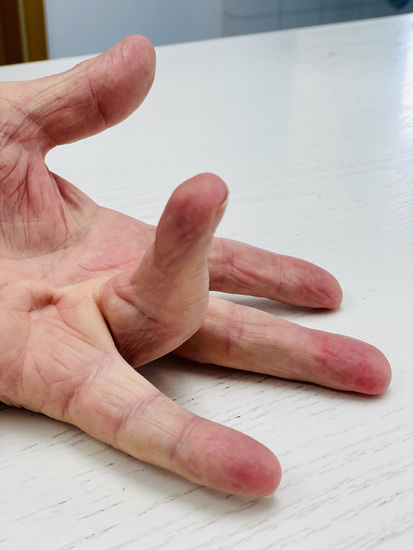About Dupuytren’s contracture
What is Dupuytren’s contracture?
Dupuytren’s contractures affect the hands and fingers. It may be referred to as Dupuytren’s disease as not everyone will develop contractures.
Initially there is a thickening to the soft tissues in the palm of the hand which may shorten and lead to a contracture. A contracture is when the fingers start to bend and this is most likely to occur in the ring finger first followed by the little finger and index finger. This can occur over months or even years.
There is usually very little pain associated with Dupuytren’s contractures but they can cause difficulties with the function of the hand.
People with Dupuytren’s may have thickening under the skin in other parts of the body such as the feet or penis.

What causes Dupuytren’s?
It is not known what causes Dupuytren’s but there are likely to be genetic factors as it often runs in families. It is also more common in people with diabetes, epilepsy and alcohol dependency. It is not caused by working with vibrating tools or manual labour.
Who gets Dupuytren’s?
It is more likely to affect people of European origin and affects more men than women. It is also more likely to occur in middle-age onwardsbut can affect younger adults. It is quite common in older people with 1 in 6 men over 65 having some degree of Dupuytren’s.
Do I need treatment?
Treatment is only necessary when the function of the hand is significantly affected as Dupuytren’s should not be a painful condition.
What treatments are available?
There are a number of none surgical treatments available for patients with Dupuytren’s contractures which may consist of splinting, injections or radiotherapy.
- Splinting of the hand is sometimes carried out to stop the progression of the contractures but the effectiveness of this is debatable.
- Injections of different substances such as steroids and collagenase may be used in the early stages of contractions to slow down the thickening process but the use of these will depend on the severity of the contractures.
- Radiotherapy uses several low doses of X-rays to soften the contractures and stop or slow down the progression of the contractures. There may be side effects of radiotherapy which means they may not be available at all treatment centres.
Surgery
There are two main surgical options which include needle aponeurotomy and open fasciectomy. Needle aponeurotomy uses a needle to cut the thickened tissue under the skin. It is done under local anaesthetic and can be done in an out-patients clinic. Open fasciectomy is a slightly bigger operation and involves the surgeon opening the skin over the thickened tissue and cutting it out. Although it is a bigger operation it can still be done under local anaesthetic as a day case but it does offer the best chance of a long-term cure.


